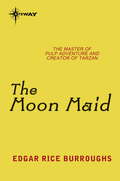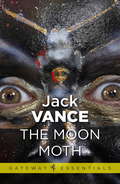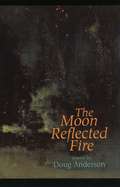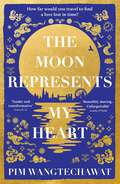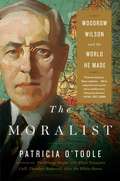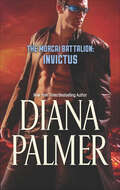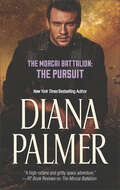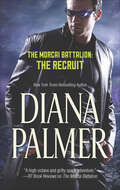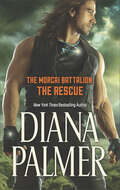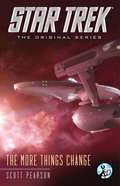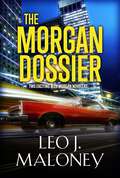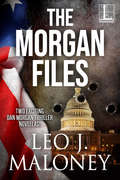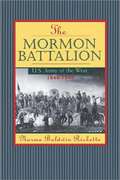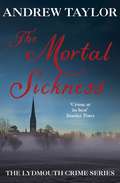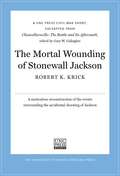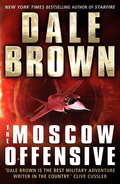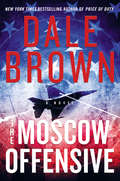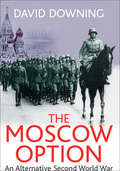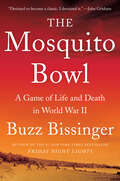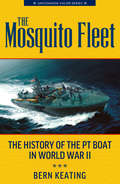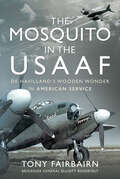- Table View
- List View
The Moon Maid
by Edgar Rice BurroughsIn the late twentieth century, Admiral Julian 3rd can get no rest, for he knows his future. He will be reborn as his grandson in the next century to journey through space and make an ominous discovery inside the moon; he will live again in the dark years of the twenty-second century as Julian 9th, who refuses to bow down to the victorious Moon Men; and as Julian 20th, the fierce Red Hawk, he will lead humanity's final battle against the alien invaders in the twenty-fifth century. The Moon Maid is Edgar Rice Burroughs's stunning epic of a world conquered by alien invaders from the moon and of the hero Julian, who champions the earth's struggle for freedom, peace, and dignity.
The Moon Moth and Other Stories (Gateway Essentials #206)
by Jack VanceWhen an out-worlder's body was found in the river, Thissel knew where the criminal was - behind one of the masks worn by the remaining out-worlders on Sirene. But how could he tell which one, on a world where everybody lived behind masks, where men never spoke but sang to instruments, and where any act of intervention with another man's business was punishable by death!
The Moon Reflected Fire
by Doug AndersonOf The Moon Reflected Fire and its subject, the Vietnam War, poet James Tate writes: "These are trenchant, wrenching poems. With artistry and honesty they perform an inquest into war and its corrosive after effects."
The Moon Represents My Heart
by Pim Wangtechawat'A beautiful exploration of family, love and loss across the generations. Fresh, fun... I didn't want it to end.' Gemma ChanHow far would you travel to find a love lost in time? 1927, East London. The first time Tommy and Peggy meet, they are nine years old. He is lost in London's original Chinatown, panicking as he struggles to escape the tangle of Limehouse streets, with their road signs in Chinese characters that he can't decipher. 'Where do you come from?' Peggy asks him. For Tommy, the answer to that question can never be straightforward, because his family share a secret gift: they can travel through time. And each must eventually decide how much the present day means to them, and how far they are willing to travel to hold onto the people they love. Heartfelt and hopeful, weaving through decades and across continents, The Moon Represents My Heart is an unforgettable debut about one extraordinary family, the gift that threatens to tear them apart and the love that binds them together. 'An immediately compelling, unusual story with a totally fresh voice.' Jennifer Saint, author of Ariadne
The Moralist: Woodrow Wilson and the World He Made
by Patricia O'Toole“O’Toole does full justice to Wilson’s complexities, but it is with the coming of the war that her narrative takes on something close to Shakespearean dimensions...scrupulously balanced...elegantly crafted.”—The Wall Street Journal “Enlightening...O’Toole has done students of American history a great service.”—National Review By the author of acclaimed biographies of Theodore Roosevelt and Henry Adams, a penetrating biography of one of the most high-minded, consequential, and controversial US presidents, Woodrow Wilson (1856-1924). The Moralist is a cautionary tale about the perils of moral vanity and American overreach in foreign affairs.In domestic affairs, Wilson was a progressive who enjoyed unprecedented success in leveling the economic playing field, but he was behind the times on racial equality and women’s suffrage. As a Southern boy during the Civil War, he knew the ravages of war, and as president he refused to lead the country into World War I until he was convinced that Germany posed a direct threat to the United States. Once committed, he was an admirable commander-in-chief, yet he also presided over the harshest suppression of political dissent in American history. After the war Wilson became the world’s most ardent champion of liberal internationalism—a democratic new world order committed to peace, collective security, and free trade. With Wilson’s leadership, the governments at the Paris Peace Conference in 1919 founded the League of Nations, a federation of the world’s democracies. The creation of the League, Wilson’s last great triumph, was quickly followed by two crushing blows: a paralyzing stroke and the rejection of the treaty that would have allowed the United States to join the League. After a backlash against internationalism in the 1920s and 1930s, Wilson’s liberal internationalism was revived by Franklin D. Roosevelt and it has shaped American foreign relations—for better and worse—ever since.
The Morcai Battalion: Invictus (The Morcai Battalion #3)
by Diana PalmerA dangerous mission tests the relationship between a surly commander and a sassy doctor in this action-packed, romantic science fiction epic. For almost three years, Dtimun, the enigmatic and mysterious Cehn-Tahr commander of the Morcai Battalion, has been at war not only with the Rojok Dynasty . . . but also with his feisty medical chief of staff, Dr. Madeline Ruszel. Now a surprising visitor from the future has charged them with the rescue of the enemy, field marshal Chacon. To ensure success, both Madeline and Dtimun must make personal sacrifices and attempt a dangerous mission behind enemy lines. Sparks fly as each twist and turn throws them closer together than they've ever been before, but can they resist acting on desires they have long denied? If their plans are discovered, they face exile by their own governments and possibly even execution. If they do not act, the future will see the end of civilization itself . . . Praise for The Morcai Battalion: Invictus &“This futuristic romance is action-packed and will please fans of Marcella Burnard and Katherine Allred. Readers new to the series will enjoy Kyle's well-conceived universe and the different modes of government and acceptable social interaction that make for a wealth of possibilities in this tale.&” —RT Book Reviews
The Morcai Battalion: The Pursuit (The Morcai Battalion #5)
by Diana PalmerA doctor must work with the military commander she left broken hearted in this intergalactic tale of impossible love by a New York Times bestseller. The first time Mekashe, Captain of the Imperial Guard, meets blue-eyed human beauty Jasmine Donally, the two nearly come to blows. Forever devoted to the Cehn-Tahr, Mekashe is forced to sever ties with the object of his adoration. Years pass before their paths cross again, but Mekashe hasn&’t forgotten what transpired—or the way she makes his heart race. But even if he can forgive the past, insurmountable barriers still threaten to keep them worlds apart. With their mutual attraction escalating quickly, they&’ll have to find a way to bridge the gap—or be lost to each other forever. Praise for The Morcai Battalion: The Pursuit &“Palmer&’s futuristic, interspecies romance is a sweet story with a sad and tragic twist. Readers will truly wonder if these two protagonists will ever get past their differences and have the happy ending that they truly deserve.&” —RT Book Reviews
The Morcai Battalion: The Recruit (The Morcai Battalion #2)
by Diana PalmerA forbidden romance blossoms between a human combat surgeon and an alien military commander as they fight together for peace in this thrilling space epic. A prophecy foretold: Three years after the unprovoked attack on a peaceful colony, the war between the Rojok dynasty and the Tri-Galaxy Fleet rages on. Born of that war is the Morcai Battalion, a fleet comprised of Centaurians and humans—the first collaboration of its kind and a step toward an intergalactic alliance. But the fragile union is tested as their courageous commander in chief, Dtimun, is faced with the temptation of the forbidden—and human—Dr. Madeline Ruszel. A combat surgeon, Ruszel is aware of the danger of inciting a Centaurian&’s interest, even if he is the most intriguing of men. Besides putting their mission at risk, personal relations between their kinds are still outlawed. But a prophecy that touches on both their lives and the future of all alien nations hints that a greater unity may be theirs for the taking . . . if they, and their crew, survive in the battle for peace. Praise for Diana Palmer and her work&“A high-octane and gritty space adventure.&” —RT Book Reviews on The Morcai Battalion&“Fans of stark outer space military science fiction will appreciate this sobering at war thriller.&” —The Best Reviews on The Morcai Battalion&“Palmer . . . is the queen of desperado quests for justice and true love.&” —Publishers Weekly on Dangerous
The Morcai Battalion: The Rescue (The Morcai Battalion #4)
by Diana PalmerA gruff military commander can&’t ignore his feelings for a shy colleague in this edge-of-your-seat, romantic space epic by a New York Times bestseller. Rhemun, commander of the Cehn-Tahr Holconcom, has worked tirelessly to get where he is—and he's not going to let any human drag him back down. Especially not Lt. Commander Edris Mallory, whose very presence aboard the Morcaiserves as a too-painful reminder of a past tragedy he can neither forgive nor forget. But Mallory has secrets of her own—ones she can&’t afford to see come to light. Frantic to protect herself, she flees, abandoning her position. When Rhemun learns of her devastating situation, he realizes the all-consuming feelings he's harbored for her may not be hatred. But in a vast universe rife with peril, is it already too late? Praise for The Morcai Battalion: Invictus &“This futuristic romance is action-packed and will please fans of Marcella Burnard and Katherine Allred. Readers new to the series will enjoy Kyle&’s well-conceived universe and the different modes of government and acceptable social interaction that make for a wealth of possibilities in this tale.&” —RT Book Reviews
The More Things Change (Star Trek: Vanguard )
by Scott PearsonA thrilling e-novella based on Star Trek: The Original Series! Six months after the events of Star Trek: The Motion Picture, Doctor Christine Chapel and Spock must save the life of an ailing Audrid Dax, her true nature as a Trill having remained a mystery until now. But after an unknown vessel attacks their shuttle, a risky game of cat-and-mouse may be the only way to save all their lives.
The Morgan Dossier: Two Exciting Dan Morgan Thriller Novellas (A Dan Morgan Thriller)
by Leo J. MaloneyOperative Dan Morgan is the ultimate force—an American hero weaponized for any contingency, his instincts honed to risk everything. Now you can read two heart-pounding Dan Morgan novellas in one electrifying volume. DARK TERRITORY Alex Morgan, daughter of CIA veteran Dan Morgan, is on a dangerous assignment outside Vladivostok, Russia, when she boards the Trans-Siberian Railway to make her escape. But she&’s not the only passenger with a hidden agenda. Now Dan Morgan has an impossible choice to make. Either he saves his daughter before fighter jets blow up the train, or he stops a madman from annihilating the world. Either way, this train ride is a one-way ticket to World War III. DEEP COVER Agents Dan Morgan and Peter Conley successfully got themselves thrown into prison in Istanbul. Now comes the hard part of the mission: extract a scientist who masterminded Turkey&’s new missile guidance system—without triggering a Middle East war. When an enemy from Morgan&’s past threatens the operation, the two agents face a desperate fight for their lives, with the fate of two hemispheres hanging in the balance. Praise for Leo J. Maloney and His Novels &“Maloney is the new master of the modern spy game.&”—Mark Sullivan &“Fine writing and real insider knowledge make this a must.&”—Lee Child on Twelve Hours &“Dan Morgan is one of the best heroes to come along in ages.&”—Jeffery Deaver &“Leo Maloney has a real winner . . . Gritty and intense, it draws you immediately into the action and doesn&’t let go.&”—Marc Cameron on For Duty and Honor &“Rings with authenticity.&”—John Gilstrap on Termination Orders
The Morgan Files (A Dan Morgan Thriller)
by Leo J. MaloneyWhen the world is pushed to the brink of disaster, there&’s only one man to call. Dan Morgan has been trained for any contingency and is prepared to risk everything—an American hero unlike any other. Now you can read two heart-pounding Dan Morgan novellas in one electrifying volume. TWELVE HOURS Exploding bombs, Islamic terrorists, and catastrophic battles have ruptured all sectors of New York City. They&’re part of an insidious plot targeting a visiting head of state. Dan Morgan knows what he has to do to prevent an irreversible domino effect designed to bring the world to its knees. There&’s just one catch. Morgan&’s teenage daughter is trapped among the hostages . . . FOR DUTY AND HONOR Captured by the Russians. Imprisoned in the Gulag. Tortured by his most sadistic enemy. But Dan Morgan knows that every prisoner has a past—and every rival can be used. That&’s when the stakes go sky-high. Dan Morgan&’s got to keep fighting. For duty. And honor. And even certain death . . . Praise for Leo J. Maloney and His Novels&“Fine writing and real insider knowledge make this a must.&”—Lee Child on Twelve Hours &“Leo Maloney has a real winner . . . Gritty and intense, it draws you immediately into the action and doesn&’t let go.&”—Marc Cameron on For Duty and Honor &“Dan Morgan is one of the best heroes to come along in ages.&”—Jeffery Deaver &“Rings with authenticity.&”—John Gilstrap on Termination Orders &“Maloney is the new master of the modern spy game.&”—Mark Sullivan Visit us at www.kensingtonbooks.com
The Mormon Battalion
by Norma RickettsFew events in the history of the American Far West from 1846 to 1849 did not involve the Mormon Battalion. The Battalion participated in the United States conquest of California and in the discovery of gold, opened four major wagon trails, and carried the news of gold east to an eager American public. Yet, the battalion is little known beyond Mormon history. This first complete history of the wide-ranging army unit restores it to its central place in Western history, and provides descendants a complete roster of the Battalion's members.
The Mortal Sickness: The Lydmouth Crime Series Book 2
by Andrew Taylor'Andrew Taylor is a master story-teller' Daily Telegraph From the No.1 bestselling author of The Ashes of London and The Fire Court, this is the second instalment in the acclaimed Lydmouth seriesWhen a spinster of the parish is found bludgeoned to death in St John's, and the church's most valuable possession, the Lydmouth chalice, is missing, the finger of suspicion points at the new vicar, who is already beset with problems.The glare of the police investigation reveals shabby secrets and private griefs. Jill Francis, struggling to find her feet in her new life, stumbles into the case at the beginning. But even a journalist cannot always watch from the sidelines. Soon she is inextricably involved in the Suttons' affairs. Despite the electric antagonism between her and Inspector Richard Thornhill, she has instincts that she can't ignore . . .'An excellent writer. He plots with care and intelligence and the solution to the mystery is satisfyingly chilling' The Times'The most under-rated crime writer in Britain today' Val McDermid 'There is no denying Taylor's talent, his prose exudes a quality uncommon among his contemporaries' Time Out
The Mortal Sickness: The Lydmouth Crime Series Book 2
by Andrew Taylor'Andrew Taylor is a master story-teller' Daily Telegraph From the No.1 bestselling author of The Ashes of London and The Fire Court, this is the second instalment in the acclaimed Lydmouth seriesWhen a spinster of the parish is found bludgeoned to death in St John's, and the church's most valuable possession, the Lydmouth chalice, is missing, the finger of suspicion points at the new vicar, who is already beset with problems.The glare of the police investigation reveals shabby secrets and private griefs. Jill Francis, struggling to find her feet in her new life, stumbles into the case at the beginning. But even a journalist cannot always watch from the sidelines. Soon she is inextricably involved in the Suttons' affairs. Despite the electric antagonism between her and Inspector Richard Thornhill, she has instincts that she can't ignore . . .'An excellent writer. He plots with care and intelligence and the solution to the mystery is satisfyingly chilling' The Times'The most under-rated crime writer in Britain today' Val McDermid 'There is no denying Taylor's talent, his prose exudes a quality uncommon among his contemporaries' Time Out
The Mortal Wounding of Stonewall Jackson
by Robert K. KrickThe stunning Confederate victory at Chancellorsville came at an enormous cost: an estimated 13,000 Confederate casualties. The most prominent, of course, was Stonewall Jackson, who was wounded by friendly fire and died several days later, on 10 May 1863. This Civil War Short presents Robert K. Krick's authoritative investigation into the incident that resulted in Jackson's death. This work was originally published as "The Smoothbore Volley That Doomed the Confederacy" in Chancellorsville: The Battle and Its Aftermath, edited by Gary Gallagher, which places the Chancellorsville campaign in a broad context and demonstrates how its significance reverberated beyond the battlefield.UNC Press Civil War Shorts excerpt rousing narratives from distinguished books published by the University of North Carolina Press on the military, political, social, and cultural history of the Civil War era. Produced exclusively in ebook format, they focus on pivotal moments and figures and are intended to provide a concise introduction, stir the imagination, and encourage further exploration of the topic. For in-depth analysis, contextualization, and perspective, we invite readers to consider the original publications from which these works are drawn.
The Mosby Myth: A Confederate Hero In Life And Legend
by Paul Ashdown Edward CaudillScholarly analysis of the life and legend of John S. Mosby, the Gray Ghost.
The Moscow Offensive
by Dale BrownAmerica's first line of defense - Brad McLanahan and the heroes of the Iron Wolf Squadron - must counter a dangerous Russian strike from within the homeland in this cutting-edge tale from the New York Times master of the high-tech military thriller, Dale Brown.On a remote island estate, a billionaire investor sells his air freight company to a mysterious new owner. The purchaser is none other than the President of Russia, Gennadiy Gryzlov. The Russians will use these private planes to secretly transport dangerous cargo into the United States.The inept American President Stacy Anne Barbeau has failed to account for the Russian threat. But others have been vigilant and will not leave America defenseless. Brad McLanahan and the Iron Wolf Squadron have joined forces with the newly formed Alliance of Free Nations in Eastern Europe, to prepare for the attack they know is imminent. Working with the most cutting-edge technology, the team will deploy CIDs-Cybernetic Infantry Devices-twelve-foot-tall humanoid combat robots, each armed with more firepower than a conventional platoon.But their state-of-the-art weapons may not be enough to combat the threat. The Russians have managed to reverse engineer their own combat robots nearly decimated in a previous attack, and have slowly begun smuggling them across America's borders. Dealing with an unprecedented danger and a feckless president and congress, McLanahan and the Iron Wolf Squadron will once again put their own lives on the line to check this new Russian peril and keep the home of the brave and the free world safe.
The Moscow Offensive: A Novel (Patrick Mclanahan Ser. #22)
by Dale BrownAmerica’s first line of defense—Brad McLanahan and the heroes of the Iron Wolf Squadron—must counter a dangerous Russian strike from within the homeland in this cutting-edge tale from the New York Times master of the high-tech military thriller, Dale Brown.On a remote island estate, a billionaire investor sells his air freight company to a mysterious new owner. The purchaser is none other than the President of Russia, Gennadiy Gryzlov. The Russians will use these private planes to secretly transport dangerous cargo into the United States.The inept American President Stacy Anne Barbeau has failed to account for the Russian threat. But others have been vigilant and will not leave America defenseless. Brad McLanahan and the Iron Wolf Squadron have joined forces with the newly formed Alliance of Free Nations in Eastern Europe, to prepare for the attack they know is imminent. Working with the most cutting-edge technology, the team will deploy CIDs—Cybernetic Infantry Devices—twelve-foot-tall humanoid combat robots, each armed with more firepower than a conventional platoon.But their state-of-the-art weapons may not be enough to combat the threat. The Russians have managed to reverse engineer their own combat robots nearly decimated in a previous attack, and have slowly begun smuggling them across America’s borders. Dealing with an unprecedented danger and a feckless president and congress, McLanahan and the Iron Wolf Squadron will once again put their own lives on the line to check this new Russian peril and keep the home of the brave and the free world safe.
The Moscow Option: An Alternative Second World War
by David DowningThis provocative alternative history looks at WWII from a new angle—what might have happened had the Germans taken Moscow in 1941. Based on authentic history and real possibilities, this unique speculative narrative plays out the dramatic and grotesque consequences of a Third Reich triumphant. In this terrifyingly plausible scenario, the Germans fight their way into the ruins of Moscow on September 30th, 1941—and the Soviet Union collapses. Although Russian resistance continues, German ambition multiplies after this signal success. They launch offensives in Africa, the Mediterranean, and the Middle East. Hitler's armies, assured of victory, make their leader's dreams reality and Allied hopes of recovery seem almost hopelessly doomed. With a convincingly blend of actual history and alternate events, The Moscow Option is a chilling reminder that history might easily have been very different.
The Mosin-Nagant Rifle (4th Revised and Expanded Edition)
by Terence W. LapinThis is a collector's guide to the "3-line rifle, Model 1891," later known as the "Mosin-system 7.62 mm Magazine Rifle, Model of 1891," and commonly referred to as the "Mosin-Nagant," in the West. Covered in-depth, are the differences, commonalities, and identifying features, for the numerous models, from the various producers. The Mosin-Nagant, rifle, and its 7.62x54R cartridge, have been important in history, from the Boxer Rebellion, and the Russo-Japanese War, to the most recent war in Iraq. This span of more than 1 hundred years has firmly established the Mosin-Nagant, and the 7.62x54R cartridge, as the most successful weapon system in modern history.
The Mosquito Bowl: A Game of Life and Death in World War II
by Buzz BissingerAn extraordinary, untold story of the Second World War in the vein of Unbroken and The Boys in the Boat, from the author of Friday Night Lights and Three Nights in August. <p><p>When the Japanese attacked Pearl Harbor, college football was at the height of its popularity. As the nation geared up for total war, one branch of the service dominated the aspirations of college football stars: the United States Marine Corps. Which is why, on Christmas Eve of 1944, when the 4th and 29th Marine regiments found themselves in the middle of the Pacific Ocean training for what would be the bloodiest battle of the war—the invasion of Okinawa—their ranks included one of the greatest pools of football talent ever assembled: Former All Americans, captains from Wisconsin and Brown and Notre Dame, and nearly twenty men who were either drafted or would ultimately play in the NFL. <p><p>When the trash-talking between the 4th and 29th over who had the better football team reached a fever pitch, it was decided: The two regiments would play each other in a football game as close to the real thing as you could get in the dirt and coral of Guadalcanal. The bruising and bloody game that followed became known as “The Mosquito Bowl.” Within a matter of months, 15 of the 65 players in “The Mosquito Bowl” would be killed at Okinawa, by far the largest number of American athletes ever to die in a single battle. <p><p>The Mosquito Bowl is the story of these brave and beautiful young men, those who survived and those who did not. It is the story of the families and the landscape that shaped them. It is a story of a far more innocent time in both college athletics and the life of the country, and of the loss of that innocence. <p><p>Writing with the style and rigor that won him a Pulitzer Prize and have made several of his books modern classics, Buzz Bissinger takes us from the playing fields of America’s campuses where boys played at being Marines, to the final time they were allowed to still be boys on that field of dirt and coral, to the darkest and deadliest days that followed at Okinawa. <p> <b>New York Times Bestseller</b>
The Mosquito Fleet: The History of the PT Boat in World War II
by Bern KeatingThe Mosquito Fleet, first published in 1963, is a classic account of America’s small but strategically important fleet of PT boats during the Second World War. The lightweight boats proved to be a significant ‘irritant’ to the enemy in terms of their effectiveness in combat, hence the nickname ‘Mosquito.’ The book covers the use of PT boats in the Pacific, Atlantic and Mediterranean theaters, and is based on action reports, squadron histories, and other naval records, plus diaries, letters, anecdotes, etc. supplied by PT crewmen. Included are six maps.Author Bern Keating served as a communications officer in the U.S. Navy during World War II, and was the author of a number of history-related books. He passed away in 2004.
The Mosquito Story (The Story Series)
by Martin W. BowmanWhen de Havilland proposed, in 1938, an unarmed bomber constructed almost entirely from wood, few would have thought it could become one of the most versatile aircraft of the Second World War.The Mosquito easily outran a Spitfire on its test flight and was ordered into mass production, soon proving itself a key weapon in the fight against the Luftwaffe by day and the Nachtjagd by night. Illustrated throughout with previously unpublished photographs, this book tells the story of an aircraft which was for many the perfect synthesis of power and beauty. Author Martin Bowman describes the service histories and daring exploits of the 7,781 examples of the ‘Wooden Wonder’ which were built in the UK, Canada and Australia.
The Mosquito in the USAAF: De Havilland’s Wooden Wonder in American Service
by Tony FairbairnOn 20 April 1941, a group of distinguished Americans headed by the US Ambassador to the United Kingdom, John Winant, and which included Major General Henry ‘Hap’ Arnold, Chief of the US Army Air Corps, visited the de Havilland Aircraft Company’s airfield at Hatfield, England. The party was there ostensibly to gain an insight into how various US aircraft supplied to Britain were performing, as well as to observe some of the latest British products being put through their paces. The eighteen types on display included both US and British bombers and fighters. But the star of the day was undoubtedly the de Havilland Mosquito. Having first flown only a few months earlier, on 25 November 1940, the aircraft that was put through its paces was flown by none other than Geoffrey de Havilland. Striving to impress the trans-Atlantic visitors, de Havilland provided an outstanding display of speed and manoeuvrability. It was a routine that impressed the Americans and left them in no doubt as to the Mosquito’s abilities. Though the visitors harboured doubts about an aircraft made of wood, they returned to the United States with full details of the design. The Mosquito had also caught the eye of Elliott Roosevelt, son of the US President and a serving officer in the USAAC. An early specialist in military aerial mapping and reconnaissance, ‘ER’ swiftly realized the value of the Mosquito in the reconnaissance role and began lobbying vigorously for its acquisition. The Air Ministry duly noted ‘ER’s’ interest and influence. Following America’s entry into the war, formal requests for Mosquitoes began in earnest in 1942. Initial deliveries for evaluation purposes in the United States soon followed in June 1943, the aircraft initially being supplied by de Havilland Canada. From February 1944 a steady flow of the photographic reconnaissance version, from Hatfield, were provided to what would become the USAAF’s 25th Bomb Group at Watton, England. There they served with distinction in a variety of specialist roles, including day and night photography, weather reconnaissance, ‘chaff’ (Window) dropping, scouting for the bomber force, raid assessment, and filming of special weapons projects. A number of these Mosquitoes, serving with the 492nd Bomb Group at Harrington, were involved in the so-called ‘Joan-Eleanor’ project, working with OSS secret agents on the Continent. Finally, in 1945, the USAAF received much-anticipated night fighter Mosquitoes which enjoyed combat success with the 416th Night Fighter Squadron in Italy. In this highly illustrated work, the author explores the full story of why the Americans wanted Mosquitoes, how they went about obtaining them, and their noted success and popularity with USAAF units.
